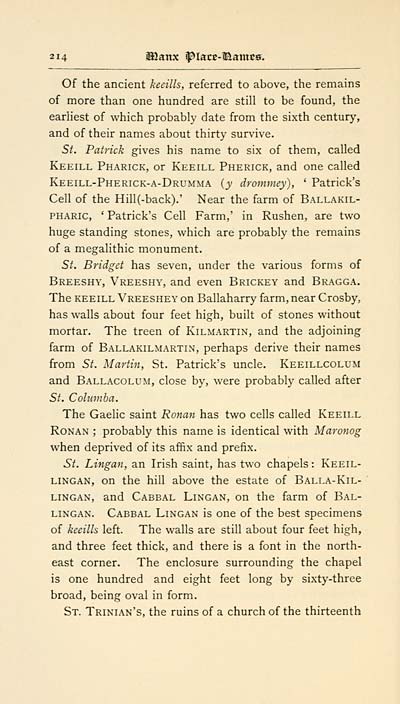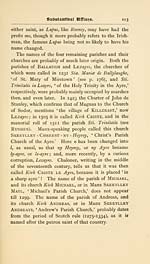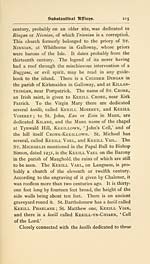Download files
Complete book:
Individual page:
Thumbnail gallery: Grid view | List view

214 Slanx ptacc-MantE0.
Of the ancient keeills, referred to above, the remains
of more than one hundred are still to be found, the
earliest of which probably date from the sixth century,
and of their names about thirty survive.
St. Patrick gives his name to six of them, called
Keeill Pharick, or Keeill Pherick, and one called
Keeill-Pherick-a-Drumma (y drommey), ' Patrick's
Cell of the Hill(-back).' Near the farm of Ballakil-
pharic, ' Patrick's Cell Farm,' in Rushen, are two
huge standing stones, which are probably the remains
of a megalithic monument.
St. Bridget has seven, under the various forms of
Breeshy, Vreeshy, and even Brickey and Bragga.
The keeill Vreeshey on Ballaharry farm, near Crosby,
has walls about four feet high, built of stones without
mortar. The treen of Kilmartin, and the adjoining
farm of Ballakilmartin, perhaps derive their names
from St. Martin, St. Patrick's uncle. Keeillcolum
and Ballacolum, close by, were probably called after
St. Cohnnba.
The Gaelic saint Ronan has two cells called Keeill
RoNAN ; probably this name is identical with Maronog
when deprived of its afBx and prefix.
St. Lingan, an Irish saint, has two chapels : Keeil-
LiNGAN, on the hill above the estate of Balla-Kil-
LiNGAN, and Cabbal Lingan, on the farm of Bal-
lingan. Cabbal Lingan is one of the best specimens
of keeills left. The walls are still about four feet high,
and three feet thick, and there is a font in the north-
east corner. The enclosure surrounding the chapel
is one hundred and eight feet long by sixty-three
broad, being oval in form.
St. Trinian's, the ruins of a church of the thirteenth
Of the ancient keeills, referred to above, the remains
of more than one hundred are still to be found, the
earliest of which probably date from the sixth century,
and of their names about thirty survive.
St. Patrick gives his name to six of them, called
Keeill Pharick, or Keeill Pherick, and one called
Keeill-Pherick-a-Drumma (y drommey), ' Patrick's
Cell of the Hill(-back).' Near the farm of Ballakil-
pharic, ' Patrick's Cell Farm,' in Rushen, are two
huge standing stones, which are probably the remains
of a megalithic monument.
St. Bridget has seven, under the various forms of
Breeshy, Vreeshy, and even Brickey and Bragga.
The keeill Vreeshey on Ballaharry farm, near Crosby,
has walls about four feet high, built of stones without
mortar. The treen of Kilmartin, and the adjoining
farm of Ballakilmartin, perhaps derive their names
from St. Martin, St. Patrick's uncle. Keeillcolum
and Ballacolum, close by, were probably called after
St. Cohnnba.
The Gaelic saint Ronan has two cells called Keeill
RoNAN ; probably this name is identical with Maronog
when deprived of its afBx and prefix.
St. Lingan, an Irish saint, has two chapels : Keeil-
LiNGAN, on the hill above the estate of Balla-Kil-
LiNGAN, and Cabbal Lingan, on the farm of Bal-
lingan. Cabbal Lingan is one of the best specimens
of keeills left. The walls are still about four feet high,
and three feet thick, and there is a font in the north-
east corner. The enclosure surrounding the chapel
is one hundred and eight feet long by sixty-three
broad, being oval in form.
St. Trinian's, the ruins of a church of the thirteenth
Set display mode to: Large image | Transcription
Images and transcriptions on this page, including medium image downloads, may be used under the Creative Commons Attribution 4.0 International Licence unless otherwise stated. ![]()
| Early Gaelic Book Collections > Blair Collection > Surnames & place-names of the Isle of Man > (232) |
|---|
| Permanent URL | https://digital.nls.uk/82102432 |
|---|
| Description | A selection of books from a collection of more than 500 titles, mostly on religious and literary topics. Also includes some material dealing with other Celtic languages and societies. Collection created towards the end of the 19th century by Lady Evelyn Stewart Murray. |
|---|
| Description | Selected items from five 'Special and Named Printed Collections'. Includes books in Gaelic and other Celtic languages, works about the Gaels, their languages, literature, culture and history. |
|---|

